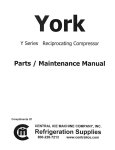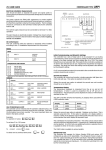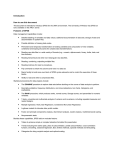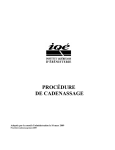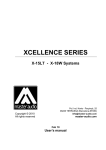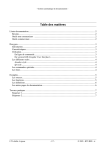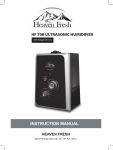Download JTL USER GUIDE COMPRESSOR PACK
Transcript
The power outputs are fitted with suppressors to protect against electrical interference when switching off solenoid valves or contactors. It is therefore essential to observe the output polarity. The line voltage should be connected to the terminals marked LN and the switched loads to LD. N LD1 LN1 LD2 IP5 LN2 LP210/220 E L N 14 13 12 11 10 9 8 7 6 5 4 3 2 1 The plant inputs are electrically isolated. Volt free contacts should be connected for the logical conditions stated below. Note inputs 2 to 5 use a common input 14. Terminals 12, 11 & 8 must be linked. SUPPRESSORS The control supply neutral must be connected to terminal 1 for EMC operation. CE Conformance This unit conforms with the relevant EU standards when installed according to the JTL Installation Requirements for this product IP4 IP3 C L N IP2 E C SUPPLY IP1 Electrical Installation Requirements Care should be taken to separate the power and signal cables to prevent electrical interference and possible damage due to inadvertent connection. C COMPRESSOR PACK SUCTION CONTROLLER TYPE: IP2 - 5 JTL USER GUIDE SUCTION PRESSURE CONTROL DISPLAY Jnet Zone MU SERIAL PORT 15 16 17 18 19 20 21 22 23 24 25 26 27 28 1 2 LD1 3 LN1 Suppressed High Suction Pressure (Alarm) 2 4 LD2 5 LN2 Suppressed Watchdog Jnet Zone PLANT ZONE Digital Output PRESSURE TRANSDUCERS (4-20mA) TEMPERATURE SENSORS (5K THERMISTOR) Doc 04289 ISS 1 Digital Inputs 1 12 13 Volt Free Auto/Manual 2 10 14 Volt Free High Discharge Pressure 3 9 14 Volt Free Enable Optimisation 4 7 14 Volt Free Low Liquid Level (LP220 only) 5 6 14 Volt Free Low Oil Level (LP220 only) The controller can be checked and the operation adjusted using a JTL portable maintenance unit which plugs into the controller. Each item of information has an item number. The more important items are listed in the tables overleaf. Examples: To read item 21 press: To set item 41 to &4.0 press: To correct errors press: To select next or previous items press: and Analogue INPUT (Pressure) Analogue INPUT (Temperature) Initial Commissioning and Bitswitch Settings The controller has 3 sets of data built in to its program for use during commissioning. These can be accessed by setting the virtual bitswitches as shown in the table overleaf. The virtual bitswitches are set using item 966. Then set item 9 to 1234. This loads into the controller a suitable set of data for the selected type of case. Adjustments should then be made as necessary. The range over which the settings can be adjusted is also defined by the bitswitch setting. 28 27 5k Thermistor Suction Gas Temperature If a JTL communications network is connected to the controller then the unit number should be set on item 1. 26 25 5k Thermistor Sensor 2 Pressure Display The pressure can be displayed in psi, bar or kPa as selected by item 179. 24 23 5k Thermistor Sensor 3 The LP210 & LP220 controller drives the JTL LCD14 display using a CAB75 cable. Various cable lengths are available. 22 21 5k Thermistor Sensor 4 20 19 5k Thermistor Plant Room Temperature 18 17 + - 4-20 mA Suction Pressure 16 15 + - 4-20 mA Not used Use of Maintenance Unit Suction Pressure Control Strategy The compressor capacity is controlled by measuring the suction gas pressure (item21) and attempting to maintain this at a constant set value within certain constraints. The suction pressure of the compressor pack is controlled by varying the number of steps of compression. The controllers can control an inverter trim compressor. When the inverter trim control is available the inverter varies the compressor speed on the trim machine to maintain the pressure. Only when the inverter driven compressor is running at minimum or maximum speed will the other compressors be stopped or started as required. JTL USER GUIDE COMPRESSOR PACK SUCTION CONTROLLER TYPE: When a change in compressor capacity is required the controller decides which step of capacity is to be changed. The decision is based on the following: • • • • • The maximum number of starts per hour on an individual compressor. The compressor running hours are balanced. All machines are run periodically. Unnecessary starts and stops of the compressors are avoided. Capacity of compressors when unequal. The suction pressure is maintained within the deadband if sufficient capacity is available. The deadband is positioned symmetrically about the suction pressure setpoint so that for example, if the setpoint is set to 8 psi and the deadband is set to 4 psi, then the bottom of the deadband is 6 psi and the top 10 psi. Under normal conditions when the suction pressure is within the deadband no increase or decrease in staged capacity will occur. Suction Pressure Optimisation When used in conjunction with a JTL suction pressure optimiser (SPO) and appropriate JTL evaporator controllers/monitors, the suction pressure can be optimised to save energy. The optimiser monitors the evaporator conditions and sets the suction pressure to the appropriate level to maintain the evaporator at the optimiser level to achieve the desired temperatures at the lowest energy. The allowed range of pressure is set on items 40 (minimum) and 152 (maximum) optimisation is enabled on item 150. CAPACITY CHANGES (STAGE CONTROL) The stage control is implemented using additional digital interface (IF) modules. One or two IF31 modules are used depending on the number of compressors and stages on the compressors. Up to 8 stages can be controlled using one IF31 module and up to 14 stages can be controlled using IF31 modules. Note when using two IF31 modules stages 1 -7 are on IF1 & 8-14 on IF2. The output arrangement for multistage compressors is controlled using item 167. Compressor output configuration (Note: When compressor 1 is set for 50% unloader then the inverter is disabled) 0 1 2 3 When compressor 1 is not set for inverter control all compressors can be used for stage control. 4 All compressors 1 stage Compressor 2 50% unload Compressors 2 & 3 50% unload Compressor 1 50% unload Compressors 1 & 2 50% unload Compressors 1 to 3 50% unload 5 LP210/220 longer the time before a capacity increase occurs. Capacity Decrease When the suction pressure goes below the control deadband the controller program will decide when and how a decrease in capacity will occur. If the pressure does not return within the deadband a change in capacity will eventually occur. As for the increase in capacity there is a minimum delay between each decrease in capacity and the pressure error is integrated with respect to time. When the integrated error is large enough a capacity decrease will occur. Capacity Decrease Response Time The speed of response of the system can be adjusted using the decrease time constant (item 45). The larger the time constant, the longer the time before a capacity decrease occurs. The use of separate increase and decrease time constants allows the compressors to unload faster than loading if desired. This feature is of particular benefit on low temperature stages to prevent the suction pressure going too low. Change Of Pressure The change of pressure is also considered. If the pressure is going towards the setpoint fast enough for the suction pressure to reach the deadband in an acceptable time then, no capacity change is made. Starts Per hour Each compressor can be programmed to have a maximum number of starts per hour. The item numbers for this selection are 219 for compressor 1, 229 for compressor 2 up to 309 for compressor 10. Once a compressor has started it is not allowed to restart again until the restart timer, which ensures the starts per hour are observed, has timed out. Compressor Capacity Each compressor can be programmed to have a capacity. The items for this data are 216 for compressor 1, 226 for compressor 2 up to 306 for compressor 10. The capacity control takes account of the capacity that can be started and stopped to ensure optimum control. Where a small capacity change can be made by starting and stopping two machines to give a net change in capacity this is done. In this condition the machine to be started always starts before the machine to be stopped regardless of whether capacity is to be increased or decreased. High Discharge Pressure If the discharge pressure exceeds the pressure safety level (on input 2) then, the compressor capacity is reduced. There is a choice of two actions in this condition on item 197 either the reduction in capacity is controlled by the normal sequence of unloading or all conpressors are stopped immediately. When the pressure falls below the safety level the capacity is allowed to increase again according to the normal requirements of the suction pressure. Capacity Increase When the suction pressure goes above the control deadband the controller will decide when and how an increase in capacity will occur. If capacity is available and the pressure does not return within the deadband a change in capacity will eventually occur. Low load Condition When the refrigeration load is low enough for the compressors to run on 1 step only (including the trim compressor) then, to prevent the last compressor stopping unnecessarily, the deadband lower limit is automatically lowered, reducing the pressure at which the last compressor would be stopped. However, the capacity change does not occur immediately the pressure goes outside the deadband. There is a minimum delay between each increase in capacity regardless of demand. In this condition the deadband lower limit is set to the 1st stage hold on pressure setpoint (item 48). The size and duration of the difference (or error) between the desired pressure and the actual pressure is taken into account. This error is integrated with respect to time. When the integrated error is large enough a capacity increase will occur. There is a very low suction pressure setting (item 196) below which, if enabled by item 195, will stop all compressors instantly. INVERTER CONTROL To put this more simply, if the pressure error is large a capacity change will occur more quickly than if the error is small. Capacity Increase Response Time The speed of response of the system can be adjusted using the increase time constant (item 44). The larger the time constant, the Inverter Speed Control The inverter requires the use of an analogue interface module (IF35) which can vary the frequency of the inverter drive is varied using a 0 10 signal. The inverter should be set up so that 0 V is for minimum speed and 10 V is maximum speed. Capacity Control The controller starts and stops the inverter as required taking account of any other compressors controlled by the same suction pressure. The inverter automatically acts as a trim compressor and all the normal compressor capacity control functions are operational. The capacity of the compressor at minimum and maximum speed is programmed on items 335 and 336. Minimum Speed When there are no other compressors running the inverter will stay on at minimum speed until the minimum pressure set on item 341 is achieved. An input is available to monitor low liquid level in the receiver. The input should be shorted out when there is no alarm condition. An alarm is given after an adjustable delay (item 175) the contact is opened. Low Oil Level (LP220 only) An input is available to monitor low oil level in the system. The input should be shortened only when there is no alarm condition. The alarm is given 10 seconds after the input occurs. Alarm Display Various alarms are indicated on the pressure displays. Typical messages displayed are: P.FlC Control Response The controller uses proportional and integrated control algorithms to control the inverter. These require speed gain (item 339) and time constant (item 340) to adjust the response of the control of inverter. Speed Output Limits The speed output can be limited at both maximum and minimum speed. The settings for the limits are item 342 for maximum and item 343 for minimum speed. MAINTENANCE FACILITY Forcing a Compressor to Run A particular compressor may be forced to run by the maintenance unit (MU) (items 217, 227 up to 307) for compressors 1 to 10 respectively. Any compressor may be forced off by the maintenance unit (items 218, 228 up to 308) for compressors 1 to 10 respectively. Resulting loading and unloading of the steps of the forced compressor(s) follows all the normal rules specified above except that the controller ignores the suction pressure on the forced compressor(s). Forced functions remain in operation for 30 minutes after the MU is unplugged, after which time the controller will reset to normal control. ALARMS Compressor Faults The individual compressors are continuously monitored. The state of these inputs for compressor 1 is shown on item 213 of the maintenance unit. Compressor 2 is on item 223 up to compressor 10 which is shown on item 503. The state is indicated by the following messages: rdy O = = ready to run (no faults) not ready (fault) If any compressor is not ready to run then this is indicated as a compressor fault (item 97). Pressure Alarms The compressor suction pressure is constantly monitored and compared with the high alarm level (item 42). If the current suction pressure goes outside the set range for a short time period then an alarm is given. The time delay is achieved by integrating the difference between the alarm level and the actual pressure over a period of 30 seconds. This means that the larger the difference the faster the alarm occurs. Pressure Transducer Alarm The pressure transducer is constantly checked and if, after a 15 minute time delay, the output goes outside the acceptable range an alarm is given (item 91). If there is a suction pressure transducer fault, the number of compression steps is set to the maximum available. Control then reverts to the compressor LP safety switches. All normal sequencing restart delays, etc will be maintained in this mode of operation. Low Liquid Level (LP220 only) Hi.Sp Hi.dP Lo.Li Cpr Plant fault (auto input not present) - (highest priority) High suction pressure High discharge pressure Low level liquid Compressor fault - (lowest priority) The alarm conditions are flashed alternately with the pressure. In the event of there being more than one alarm the highest priority alarm is displayed DAYLIGHT SAVING NETWORK When connected to a JTL network this controller can operate by displaying daylight saving time for its time and defrost schedule. Daylight saving operation is selected by setting item 18. The connected network controller then adjusts the times automatically during the daylight saving period. JTL USER GUIDE COMPRESSOR PACK SUCTION CONTROLLER TYPE: Function Range Units 40 150 152 43 44 45 48 195 196 197 Suction pressure setpoint (minimum) Suction optimisation Suction pressure (maximum) Deadband Increase time constant Decrease time constant st 1 stage and fast unload set point Low suction pressure safety Low suction pressure safety level Instant high discharge pressure shutdown 0 to 60, 100 to 200 0=Disabled 1=Enabled 5 to 60, 175 to 225 0 to 20 1 to 60 1 to 60 -8 to 60, 100 to 150 0=Disabled 1=Enabled -5 to 40, 50 to 150 0=Disabled 1=Enabled psi 42 41 High suction pressure Low suction pressure 10 to 80, 200 to 300 -5 to 40, 100 to 150 psi psi 121 421 426 Transducer Transducer full scale (at 20mA) Transducer zero scale (at 4mA) 0=Disabled 1=Enabled 50 to 200, 300 to 500 -15 to 0 psi psi 200 205 208 Number of compressors Maximum allowed to run Minimum stop time 1 to 10 1 to 10 0 to 240 sec 2x5 2x6 2x0 Isolation Capacity Control 2X9 Starts per hours 0= not in use 1= in use 1-100 0= not stage controlled. 1= stage controlled, 2=2 stages (50/100% (compressor 1-3 only) 3=2 stages (66/100%)(compressors 1-3 only) 4= inverter control (compressor 1 only) 4- 20 psi psi psi kW Select Minimum pressure Time constant Gain Minimum steps Maximum steps Capacity at minimum speed Capacity at maximum speed 0=Disabled 1=Enabled -8 to 40, 100 to 150 1 - 240 1 - 250 1 - 63 64 - 127 1 - 100 1 - 100 DISPLAY 179 Display units 1 - psi, 2 - bar, 3- kPa COMPRESSO R ALARMS 206 158 175 Fault alarm delay Fault alarm repeat delay Low refrigerant alarm delay 0 - 10 00:01 - 24:00 (00:00 off) 15 - 240 JNET FUNCTION 1 18 Unit number Daylight saving operation 0.1 - 899.7 0= standard time, 1 daylight saving time PLANT INTERFACE Note compressor 10 uses items 300-309 330 341 340 339 343 342 335 346 909 Interface communications speed 1=1200, 2=2400, 3=4800, 4=9600, 5=1920 966 Bitswitch Selection 0=Frozen Food (HFC) 1=Chilled (HFC) 2=Frozen Food (CO2) Where 0-2 is the virtual bitswitch setting on item 966. INVERTER LP110 Item VIRTUAL BITSWITCH COMPRESSORS (WHERE COMPRESSOR PRESSURE PRESSUR x IS COMPRESSOR COMMON TRANSDUCE E ALARM Pressure Control ADJUSTABLE PARAMETERS LP210/220 OTHER USEFUL ITEMS psi kW kW min hr:min min JTL USER GUIDE Item 21 146 151 153 191 181 182 201 202 203 COMPRESSOR PACK SUCTION CONTROLLER TYPE: Function PRESSURE Pressure Average pressure (1hr) CONTROL Optimised LT setpoint Optimised HT setpoint Integrated pressure error Next increase site (kw) Next decrease step (kw) PACK DATA No. of steps on load No. of compressors running Loaded capacity (kw) LP210/220 Item Function Item Function 2x3 2x2 37x 2x4 35x COMPRESSOR DATA (WHERE x IS COMPRESSOR NO.) Status Run hours (10 s of hours) Run time (last 24 hours) Restart timer Starts per hour (last 24 hours) 345 346 331 332 333 INVERTER Current proportional term current integral term Steps running Run hours (10s of hours) inverter/ compressor status 344 Capacity loaded Note compressor 10 uses items 300-309, 360-380 Relay Output Rating 2A resistive Applicable Documentation Item Numbers Firmware Variations Doc No. 03731 Doc No. 03732 Connections Diagram (LP210) Doc No. 03713 Supply Requirements Installation Information Doc No. 04257 Connections Diagram (LP220) Doc No.03979 230 V ac 48-62 Hz Supply 6 VA maximum inputs 2 mA maximum Output Configeration Doc No. 03867 24 Vac (optional Note: The information contained in this document applies to the current version of the unit supplied with it. Full operating manuals, item number and software variation information can be obtained from the supplier JTL Systems. This unit conforms with the relevant EU standards when fitted in accordance with its installation instructions. PREDICT® is the patented JTL pattern recognition algorithm for providing defrost on demand for the cabinets on a system. LP110.wpd Issue 1 Feb 2014 Doc No. 04288 www.jtl.co.uk JTL Systems Ltd . 41 Kingfisher Court . Hambridge Road . Newbury . Berks . RG14 5SJ Tel: (01635) 263646 Fax: (01635) 263647 JTL Help Desk Tel:08713157535





